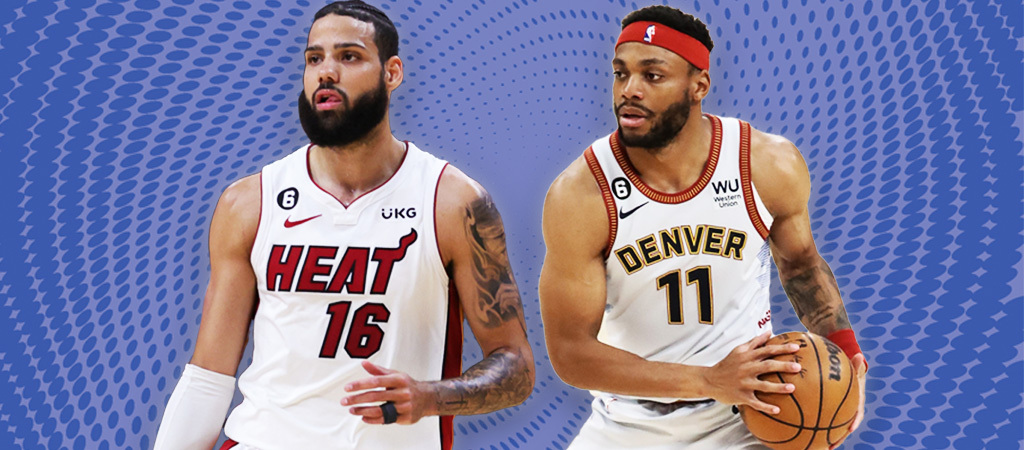These playoffs have been mercurial. Most of the star-studded, sure thing contenders have all fallen away — some in spectacularly dull displays of confusion at their own competitive mortality, others with full-bodied attempts at making history. What remains are two title challengers that shirk comfortable prediction. Part of that has been the Miami Heat and Denver Nuggets’ paths here, as both have beaten opponents in ways that range from “fluid” to “dog fight”; and part, probably the larger part, is in the way both teams are constructed.
It’s a stretch to say neither of these franchises boast big stars. Denver has an affably beguiling MVP in Nikola Jokic and the most demure lights out shooter in the league with Jamal Murray. The Heat have Jimmy Butler, a man who has become a superstar by being the biggest workaholic in the league. While it’s easy to dislike people who try too hard, Butler never has — this is just his default. Why these three certified stars are not necessarily top of mind when running down the list of the league’s biggest names has more to do with where they play than their skill-sets or personalities, though both are the reasons all three athletes play, and thrive, where they do.
Denver and Miami are made up of role-players. Chock-full of role-players, if we’re being honest. A cursory glance down either roster reveals well-rounded veterans on second- or third-chance runs, young draftees or signings brought up in those vets’ images, and players who were landed by intentional trades to match an existing system, rather than roll the dice at building around one athlete. Miami’s entire ethos, Heat Culture™, comes out of the front office’s ability to find and sign under-utilized or undervalued athletes and shape them into keen Swiss Army knife-style players. The Heat also have the sun drenched draw of South Beach and some storied franchise history to back themselves up with, but have struck a balance between development and too much reliance on attracting big names like other teams at their level.
“I don’t call them role players, I call them teammates,” Butler said in his postgame presser, after Miami beat Boston to win the Eastern Conference Finals. “Your role can change any given day, especially with how many games I’ve missed — in and out of lineups, off nights, whatever you call it. We got some hoopers. We got some real deal basketball players that can score, can defend, can pass, and can win games for us.”
To Butler’s point, the catchall of role player falls short with the Heat — at least when it comes to what we might consider the traditional construction of a competitive NBA team, where a roster with two to three role players may have cut it in the past. Even the Celtics, who almost pulled the making NBA history card on the Heat, are a team comprised of high-aptitude, high-effort athletes that looked so seamless this season because of how traditional roles, and the effort entrenched in each, were able to shift. And where the Nuggets have found the most lasting, demonstrative success has been in developing their stars while understanding their limits (due to injury, ability, matchup) and developing their role players alongside them to plug gaps dynamically.
It’s egalitarian basketball, and given the success both Denver and Miami (and Boston, and Sacramento, and New York) have found with it these playoffs, it shouldn’t be a surprise when we see more teams adopting it in seasons to come.
For smaller markets alone it’s a more lasting, less reliant on the whims of the league’s biggest names way of team building. Toronto, despite all the identify crisis stuff of the past season, has found success with the model of everyone doing a little bit of everything, to the point where the team perhaps tipped too far in the positionless direction without sufficient structure to hold it all together. Oklahoma City, with such a young roster all developing along similar timelines, could find the kind of identity it’s been craving by first defining some roles for its key players and then encouraging some democratic overlap.
The key for any team is buy-in, translated in the comfort that’s clear when watching Caleb Martin dive for an out of bounds ball as decisively as he demands the ball from Butler because both realize Martin has the better shot, or the way Bruce Brown can toggle between being a guard, running the ball down the floor, and being the easy outlet for Jokic or Murray for under the basket finishes and careening dunks.
What makes the rise of role players feel less like a trend, or an anomaly fix for developing teams, is how the best teams have leaned on them to win and the inverse, where the supposed better teams didn’t and lost. The Suns traded away Mikal Bridges, an elite defender and intuitive offensive player, for Kevin Durant and looked flat against Denver through their six game series. Against the relentless, spontaneous to sloppy Heat, the Bucks had no backup option once it was clear their crisp and concise gameplay wasn’t going to hack it.
While the adoption of more role players, or role players in bigger and sustained roles, is going to catch on, it may be the only team trend that can’t be outright copied. To make it work, front offices will have to resort to trial and error and be open, to some extent, to blowing it. No team’s structure is quite the same, given roster age, contract lengths, inherent skills, how developed the development arm of the franchise, or myriad other factors. Not all front offices (or ownership groups) sit so comfortably with the idea of embarrassment, or the patience needed to back something new without immediate payoff. The line of best fit won’t and can’t be direct, but it’s going to be paved by role players.







